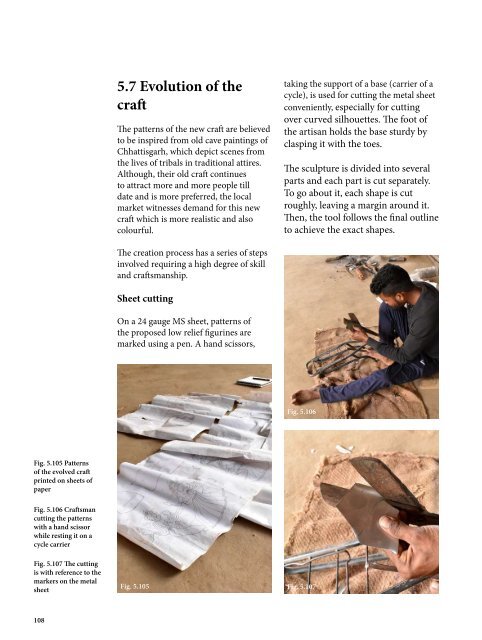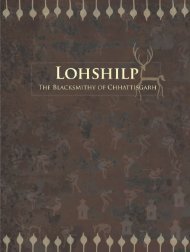CRAFT DOC_compressed
You also want an ePaper? Increase the reach of your titles
YUMPU automatically turns print PDFs into web optimized ePapers that Google loves.
5.7 Evolution of the<br />
craft<br />
The patterns of the new craft are believed<br />
to be inspired from old cave paintings of<br />
Chhattisgarh, which depict scenes from<br />
the lives of tribals in traditional attires.<br />
Although, their old craft continues<br />
to attract more and more people till<br />
date and is more preferred, the local<br />
market witnesses demand for this new<br />
craft which is more realistic and also<br />
colourful.<br />
taking the support of a base (carrier of a<br />
cycle), is used for cutting the metal sheet<br />
conveniently, especially for cutting<br />
over curved silhouettes. The foot of<br />
the artisan holds the base sturdy by<br />
clasping it with the toes.<br />
The sculpture is divided into several<br />
parts and each part is cut separately.<br />
To go about it, each shape is cut<br />
roughly, leaving a margin around it.<br />
Then, the tool follows the final outline<br />
to achieve the exact shapes.<br />
The creation process has a series of steps<br />
involved requiring a high degree of skill<br />
and craftsmanship.<br />
Sheet cutting<br />
On a 24 gauge MS sheet, patterns of<br />
the proposed low relief figurines are<br />
marked using a pen. A hand scissors,<br />
Fig. 5.7.2<br />
Fig. 5.106<br />
Fig. 5.105 Patterns<br />
of the evolved craft<br />
printed on sheets of<br />
paper<br />
Fig. 5.106 Craftsman<br />
cutting the patterns<br />
with a hand scissor<br />
while resting it on a<br />
cycle carrier<br />
Fig. 5.107 The cutting<br />
is with reference to the<br />
markers on the metal<br />
sheet<br />
Fig. 5.105<br />
Fig. 5.107<br />
108




